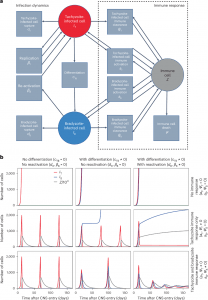Toxoplasma gondii is a parasite that infects nearly one-third of the global population. While it typically causes no symptoms in healthy individuals, it can pose serious risks to people who are pregnant or immunocompromised. After infection, the parasite enters a latent stage, forming long-lasting cysts in neurons to avoid detection and clearance by the host’s immune system.
In a discovery that challenges long-held assumptions about immune protection in the brain, researchers have found that the immune system can recognize and respond to the latent stage of Toxoplasma gondii — a parasite that infects the brain and causes toxoplasmosis. The study shows that T cells can target parasite cysts inside neurons, a revelation that has implications for treating chronic infections and neuroinflammatory diseases (Figure 1).

Figure 1: Compartmental modelling of T. gondii infection in the CNS predicts the presence of immune responses to tachyzoites and bradyzoites. a, Petri net representing the infection (left) and immune response (right) dynamics in equations (1)–(3). Circles represent different cell populations: tachyzoite- (IT, red) or bradyzoite-infected (IB, blue) cells and immune cells (Z, grey). Squares represent a particular reaction. Arrows entering a square represent reactants, and those leaving represent products. The two arrows from βT to IT represent a +1 increase in parasite numbers, and similarly, two arrows from αT (αB) to Z represent the ability of tachyzoite (bradyzoite)-infected cells to amplify the immune response. b, Graphical representations of potential outcomes for the numbers of tachyzoite-infected cells (IT, red), bradyzoite-infected cells (IB, blue) and immune cells (Z, grey) after parasite entry into the CNS, based on equations (1)–(3). Columns show different parasite dynamics: no parasite differentiation nor reactivation (cTB = 0 and dB, βB = 0; left column), differentiation but no reactivation (cTB ≠ 0 and dB, βB = 0; middle column), or both differentiation and reactivation (cTB ≠ 0 and dB, βB ≠ 0; right column). Rows show different immune responses: no immune response (aT, ψT = 0 and aB, ψB = 0; top row), immune responses against tachyzoites only (aT, ψT ≠ 0 and aB, ψB = 0; middle row), or immune responses against tachyzoites and bradyzoites (aT, ψT ≠ 0 and aB, ψB ≠ 0; bottom row). When nonzero, the parameters used were S0 = 108, IT (0) = 1, IB(0) = 0, Z(0) = 105, dT = 0.2, dB = 0.01, βT = 1.7, βB = 0.2, cTB = 0.25, aT = 105, aB = 0.2 × 105, µ = 0.1, ψT = 50, ψB = 10.
However, the new study shows that the hiding isn’t foolproof. In mice, specific T cells were able to detect and control cyst-containing neurons, suggesting that the brain’s immune surveillance is more active than previously thought.
To probe what happens when the parasite can’t form cysts, the researchers worked with a genetically modified strain of T. gondii incapable of entering latency. Surprisingly, this version of the parasite persisted in the brain and wasn’t cleared by the immune system, even six months post-infection. However, these non-cyst-forming parasites caused more brain damage than their latent counterparts. This finding upends a common belief that cyst formation is essential for long-term parasite persistence and raises new questions about why the immune system tolerates certain latent infections.
Key Takeaways:
- The immune system can recognize and interact with latent Toxoplasma cysts in neurons.
- Eliminating cyst formation leads to more brain damage, suggesting cysts may protect both host and parasite.
- Immune cells don’t clear even non-latent T. gondii—suggesting latency isn’t essential for long-term survival.
- Mathematical modeling confirmed that immune pressure affects cyst dynamics.
- Findings have broad implications for brain infections like CMV and potential immunotherapies.
This work not only reframes how we think about infection latency but also highlights how brain infections may be more immunologically dynamic than assumed, offering hope for future treatments of chronic infections and possibly even neurological diseases.
Journal article: Eberhard, J. N., et al. 2025. Immune targeting and host-protective effects of the latent stage of Toxoplasma gondii. Nature Microbiology.
Summary by Stefan Botha










